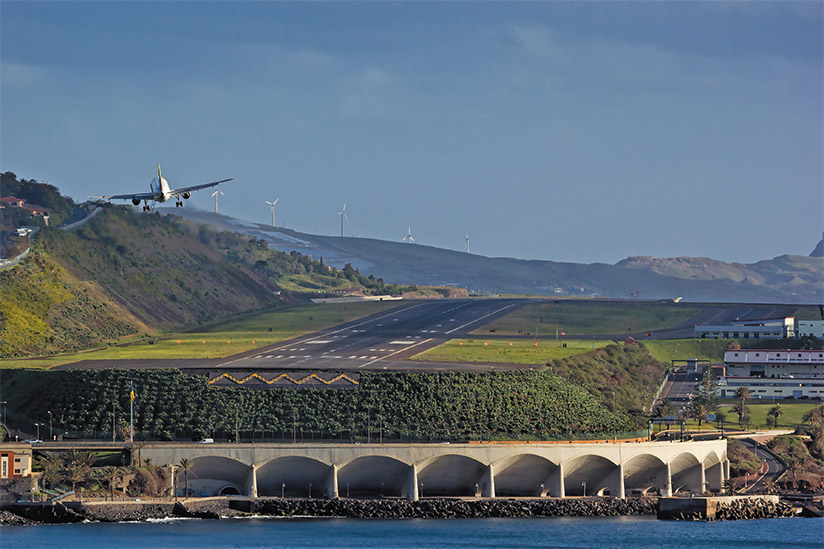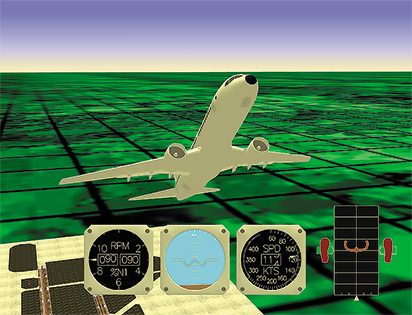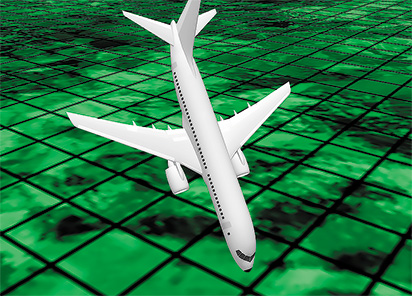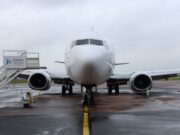
Presumed-versus-actual practices of airline pilots during unstabilized approaches are receiving close scrutiny in the light of flight data analyses shared by governments and industry. Yet a basic principle still applies, say subject matter experts. “Airlines should emphasize to flight crews the importance of making the proper go-around decision if their landing approach exhibits any element of an unstabilized approach,” said a recent article in Boeing Aero.1
Mitigating risk of the go-around maneuver itself has to be factored into every decision, according to Dave Carbaugh, a captain and chief pilot, flight operations safety, Boeing Test and Evaluation. He sees the unstabilized approach as just one reason among many well-known scenarios for conducting the maneuver, and he wants all pilots to know key lessons learned from incidents and accidents associated with the decision to go around.
In November 2014, he made a presentation to Flight Safety Foundation’s 67th annual International Air Safety Summit (IASS) in Abu Dhabi, United Arab Emirates, elaborating on the same theme as a companion Aero article that he co-authored with Bertrand de Courville.2
Important reasons for airlines and pilots to revisit long-held assumptions about the go-around maneuver include the changing nature of go-arounds compared with the circumstances two or three decades ago, and safety implications of the rarity with which they are conducted, Carbaugh said. Excessive focus on complying with stabilization criteria at specific approach gates defined by standard operating procedures creates a risk of gaps in situational awareness.
Defining approach gates at certain altitudes helps, but they should be considered as one of several phases/segments where the aircraft could become unstabilized. “If there’s a gate at 500 ft, you could end up being OK there but unstable later in the approach,” Carbaugh said. “So an unstabilized approach can occur anywhere in that period of time,” including during the landing up to the point at which the thrust-reverser system is activated.
Flight crews generate some of the conditions necessitating a missed approach. “Sometimes the situation ends up being blatantly unsafe. … [The] reason for doing a go-around is [they’re] just basically not prepared to land,” Carbaugh said. In other words, each flight crew’s real-time assessments must include objectivity about its own performance as well as that of the aircraft and issues in the environment. He cited the specific case of self-awareness of getting “behind the airplane” — that is, unable to anticipate what will occur next because of the level of concentration on present tasks. “You lose your reserve capacity to be able to handle any other activities of concern” in that case, he added.
In recent years, a significant amount of study of pilots’ go-around decision-making processes has occurred. The timing of the decision can be critical to the maneuver’s outcome. “When you look at the go-around performance data … doing a go-around is not without any risk. The lack of decision is the leading risk factor. In other words, if you’d made your decision earlier in the process, you’d probably [have been] able to execute the go-around better than [if] forced into it by having an unstabilized approach, then, at the very last second, deciding [you] have to go around,” Carbaugh said, citing European conference findings in 2013 that about 10 percent of go-arounds reviewed had potentially dangerous outcomes. “In other words, there were airspeed, altitude [or aircraft] handling-type problems that could have potentially ended up being a hazardous situation.”3
Carbaugh contrasted the relative lack of complexity of go-around maneuvers 30 years ago with what airline flight crews presently encounter. “We [formerly] had low thrust-to-weight ratios, so the airplane just didn’t climb very quickly. We had less traffic density, so there wasn’t anybody in front of you and … and a lot of times, the go-round was non-complex [such as the air traffic controller saying,] ‘Fly runway heading to 4,000.” It was basically easy. But those days are gone,” he said.
Very complex arrivals and departures create equally complex go-around situations, increasing the workload for the flight crew. There are similarities to the past in the need to monitor attitude, thrust, flight path, aircraft configuration and pitch trim. “In modern days … we have some additional things to do. We have to monitor the autopilot, the flight director and the autothrottle, their modes, and confirm back-and-forth between the pilots that the airplane is doing the right thing,” Carbaugh said.
How well an airline mitigates the current risks partly depends on insights gained from ongoing study of go-around events, such as whether a maneuver possibly endangered a flight in some respect, or whether identified problems recur at a particular airport. “We do that by flight data monitoring and incident reporting. Also, we take a look at the performance of our crews in the simulators and get feedback from our instructors on how they’re doing,” he said.
Go-Around Execution
Problems in performing go-arounds essentially fall into two categories: nose-high situations and nose-low situations, he said. All nose-high situations have common characteristics. “One of them is that they [involve] very high thrust, so things happen quickly. They tend to happen at low speeds, but speed can be an interesting problem because some airplanes have [low relative] approach speeds that are based on the go-around capability … to have controllability when you go around,” Carbaugh said. “The aircraft tend to have, in most of the accidents and incidents, an excessive amount of nose-up trim, and [flight crews] almost always end up in a situation where they are lacking pitch-down elevator control. So you just basically ‘run out’ of elevator control.”

Nose-High Situation
- Go-around thrust
- Low speed
- Nose-up trim
- Lack of pitch down control authority
One good example of a nose-high go-around incident in the United Kingdom involved a Boeing 737-300, he said, without further identification except that his examples are not recent. “Similar accidents are happening today, so the issues are still pertinent,” he added. “Sometime during the approach, the autothrottle was disengaged … at a lower-than-needed or normal power setting, which allowed the airplane to slow down near to the stall. The autopilot was still on, so the [autopilot] was still trimming and trying to hold pitch for the lower speed. The captain [pilot flying] noticed the low speed at just about the time they reached minimums and decided to go around. Unfortunately, it was a very exciting situation for them. He grabbed the throttles and pushed them all the way up to the firewall, which — in a 300 — is an overboost-type situation,” Carbaugh said, highlighting the dangerous combination of full power, far more power than required, and a large amount of nose-up trim.
“The airplane pitched up, and they were using elevator-only to recover; they didn’t have enough elevator authority, and the airplane stalled. Fortunately, it fell straight ahead and recovered, and the second time [the nose] started to come up, they used some stabilizer trim and recovered. … We’ve had a number of issues that are similar with the [Airbus] A300-600s and A310s. … Pilots were making the wrong [control] inputs and the trim was compensating for it … basically [cases of] mishandling by the flight crew.”
Part of the threat involved in a nose-high go-around situation is the unlikelihood of the flight crew expecting this to occur or having practiced correct procedures. “They are very rare but they happen every once in a while. The flight crew gets startled,” he said. Correct response can be learned using procedures taught in standardized upset prevention and recovery training (UPRT) courses that incorporate guidance published in the free Airplane Upset Recovery Training Aid, Revision 2 (2008; ASW, 3/15).
At IASS, Carbaugh paraphrased the procedure: “Basically, it’s [recognize] the situation. Disengage the autopilot and the autothrottle, as they may be causing some of the problems. Apply full nose-down elevator if you don’t already have it. And then, if you’re holding pressure at full-down elevator, obviously you’re going to need some nose-down stabilizer trim, so use that. … Too much thrust may be causing it, so … why don’t we just pull the thrust back a little bit to prevent the pitch-up. … If all of that doesn’t work to reduce the pitch rate, you can always roll, and that will definitely [make] the pitch come down. Once you get the airplane to [begin to] recover under control, you can [fully] recover, roll the wings level near the horizon and airspeed — and attitude-adjust.”
Nose-Low Situations
The nose-low situations — many occurring when the flight crew is “forced” by air traffic control (ATC) instructions or other factors to perform a low-altitude level-off — also involve some within-category similarity of sequence. “They are characterized by steep climbs followed by steep descents. [The flight crews were] pitching up, but then, all of a sudden, they had to make a change and level off. They’re all at night or in the weather, where they don’t have a discernible horizon. Many times, they started to go around at a not-frequently-trained location … a phase in the approach that they don’t usually see in training,” Carbaugh said.

Nose-Low Situation
- Low altitude level-offs
- Steep climbs followed by steep descents
- Night or weather
- Started go-around at a not frequently trained location
Initiating a go-around maneuver at higher altitudes adds other challenges — notably a greater risk of spatial disorientation for the pilot flying. “If you’re told to go around at 1,500 ft, partially configured, that could end up a way-different situation and quite startling. To have to go around at that point and to figure out what to do [has] been a cause of some problems,” he said. In addition to the frequently cited A320 accident (ASW, 10/07) at Sochi, Russia, he summarized 757 nose-low go-arounds that occurred in Oslo, Norway, and Seychelles.
“[In the low-visibility-weather Oslo event,] they started their go-around at a very high height, relatively — at 1,500 ft AGL [above ground level], and they only had 1,000 ft to climb for their low-altitude level-off. … When they added power, they didn’t climb right away, they just kind of accelerated. They were at flaps 20 at the time,” Carbaugh said. “In the Boeing [automation] system, normally when you select ‘GO AROUND,’ it gives you a 2,000 fpm rate of climb.” If the aircraft does not climb at the programmed rate, however, the software algorithms “presume” that the situation requires more power, he noted.
“So they ended up at full thrust, and then they did a steep climb up to 2,500 [ft], and then a very long, pronounced, pitch-down [occurred] in which they reached minus 40 degrees nose-low. Ground prox [the Enhanced Ground Proximity Warning System] went off — although the pilots said they never heard it — [and] they performed a 3.6-g [3.6 times standard acceleration of gravity] pullout at 400 ft AGL.” The subsequent landing was uneventful, and data from the flight data recorder facilitated incident analysis by Boeing.
The Seychelles example involved night operation over the sea. “They … had a low-altitude level-off, and there was a long pitch-down input which reached 9 degrees nose-low. Anybody would know that if you’re flying level or you’re doing a go-around, 9 degrees nose-low is not a good place to be. … They ended up having a vertical speed of about minus 4,000 fpm [and] recovering at 600 ft AGL,” he said, noting the prevalence in many cases of spatial disorientation, high-workload distraction or an unmitigated physical effect such as somatogravic illusion (that is, the airplane’s sudden acceleration affects the balance organs of the pilot’s inner ear, creating the sensation of being tilted backward and the false perception that the pitch attitude is excessive although it is not [ASW, 7/13]).
“The pilot [flying] reacted late to an extreme nose-down pitch attitude. So were they not looking at the ADI [attitude direction indicator]? We don’t know. … The only reference they had [for their actual] attitude was the ADI, so you would think they would be looking at it — but apparently not. They were distracted for some reason. [By] then, their control process had broken down. … The only way you’re going to be able to talk yourself into what’s happening in reality [and make appropriate flight control inputs] is to look at the ADI and figure out what’s going on. It’s very difficult.”
T-Shape Scan Pattern
Carbaugh said that among the most effective countermeasures to the nose-low go-around threat scenario is correctly monitoring flight path and energy state at all times. When hand-flying, the basics of attitude instrument flight apply as much as ever — even while scanning the most advanced ADIs, he added.
“Make sure you go back to basic instrument scan, which we learned many years ago is probably best done in a T-shape. Even though we’ve [integrated instruments] into one big display … you still have to do an instrument scan,” he said. “That’s because the [pilot’s] central vision is still needed to read the digital readouts in all of these displays, and also [because of] cognitive performance. Even though pilots will tell you, ‘Oh, I can just take a glance at the ADI or PFD [primary flight display] and see everything all in one glance — they’re not really telling you the truth. They can’t. They think they can, but they can’t. … [The T‑shape scan] takes a little bit of time, and you have to force yourself to do that. … For go-arounds, distraction [from the scan] is something that we have to manage. … At an unknown place [or relatively high altitude, flight crews] tend to rush, and they’re not sure about [airplane] performance.”
A related area of emphasis in training for go-arounds is monitoring proper pitch attitude and power management, fully realizing the possibility that any flight crew’s usual cross-check process could break down under the challenging conditions described, Carbaugh said. “If you’re doing [the maneuver] on autoflight, you definitely have to use good mode awareness. … [If] the pilot flying has [somatogravic illusion], the pilot monitoring needs to [speak up and take action]. If a [pilot’s] in real trouble, [the other’s] got to say, ‘It looks like you’re in trouble,’ and take over. It’s a difficult thing to do — but necessary,” he said. “When I brief an approach [I may say,] ‘If we have a disagreement or we’re not feeling comfortable about what the other person is doing, we need to speak up. … Instead of trying to solve it while we’re finishing the last of the landing, let’s go around. In that case, we can iron out what the problems were in the situation …so that on the next approach, we have a common viewpoint of how it’s going.”\
Finally, to make go-around maneuvers safer — regardless of the anticipated recommendations from research undertaken by Flight Safety Foundation committees and other organizations — airlines should continue to encourage and prepare their pilots to be ready and willing to execute a go-around because of unstabilized elements during approach or landing. “Vary some of the go-around initiations [in flight simulators so they occur] at different places that crews aren’t ready for. Monitor the performance of crews in the simulator as well as on the line. Then the airline needs to figure out, ‘Are we taking a close enough look at go-arounds? Are they visible enough?’”
Notes
- Coker, Michael. “Why and When to Perform a Go-Around Maneuver,” Boeing Aero, Quarter 2, 2014. Coker is lead safety pilot, Flight Services, for The Boeing Co.
- Carbaugh, David; de Courville, Bertrand. “Performing Safe Go-Around Maneuvers,” Aero, Quarter 3, 2014. Carbaugh is identified in the article as a captain and chief pilot, flight operations safety, for The Boeing Co. De Courville is a retired captain of Air France and co-chair of the European Commercial Aviation Safety Team.
- The Go-Around Safety Forum was held June 18, 2013, in Brussels. Sponsors were Eurocontrol, the European Regions Airline Association and Flight Safety Foundation, supported by SKYbrary. Presentations are available online at <www.skybrary.aero/index.php/Portal:Go-Around_Safety_Forum_Presentations>.
Featured image: © Rui Sousa | Madeira Planes&Stuff…
Nose-high and nose-low simulations: Airplane Upset Recovery Training Aid, Revision 2
T-shape scan pattern: The Boeing Co.


